Key takeaways:
- Food photography captures more than just images; it conveys emotions, textures, and stories behind the dining experience.
- Natural light significantly enhances the visual appeal of food, highlighting colors and details that artificial lighting cannot replicate.
- Composition and the use of props are crucial for creating inviting scenes that evoke the essence of the dish and its cultural background.
- Food photography serves not only as art but also plays a vital role in marketing and connecting with audiences on deeper emotional levels.

Understanding Food Photography
Food photography is not just about snapping a picture of a meal; it’s about capturing the essence of flavors, textures, and emotions tied to the dining experience. I remember the first time I shot a vibrant plate of jerk chicken and saw how the light caught the spices just right. It made me realize how important natural light is—without it, that dish could easily lose its inviting allure.
Have you ever tried photographing food only to find it looks bland in images? I’ve experienced that frustration, and it taught me to consider composition and styling carefully. Little details, like garnishing or the angle from which I shoot, dramatically change the viewer’s perception. It’s fascinating how a simple adjustment can transform an ordinary dish into an eye-catching masterpiece.
Looking at food photography as an art form can change your perspective entirely. Reflecting on my journey, I often ask myself: What story do I want this dish to tell? Connecting with the food on a personal level makes each shot meaningful, allowing me to evoke emotions and memories—just like those sunny afternoons spent with family enjoying a feast of local delicacies.
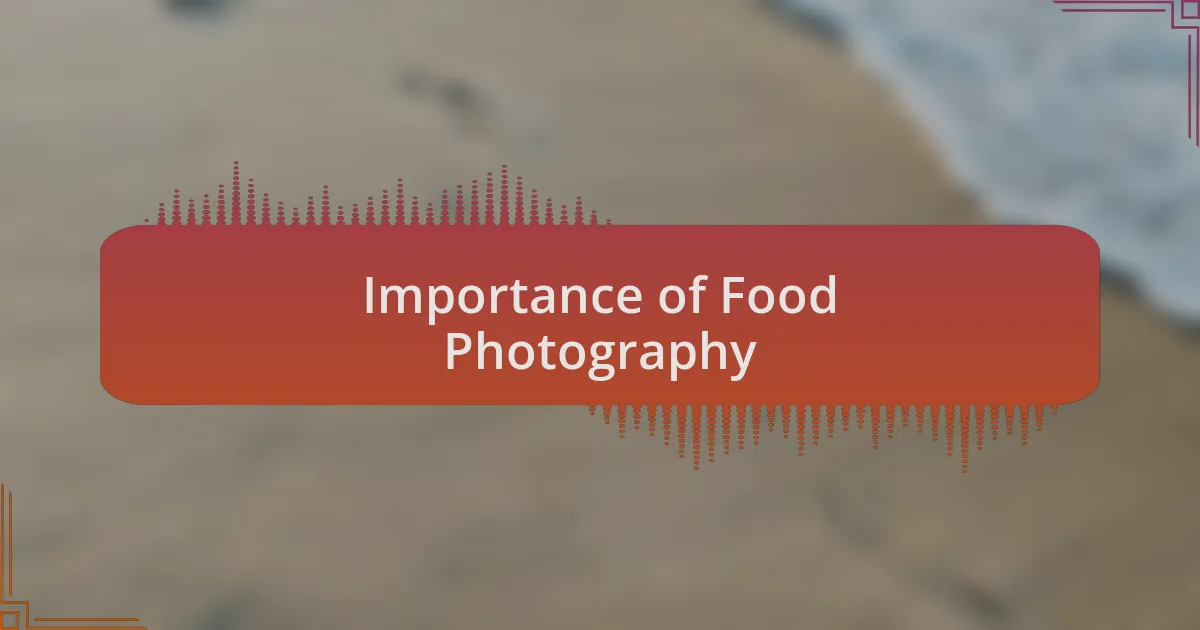
Importance of Food Photography
Capturing food through photography goes beyond mere aesthetics; it’s about enticing the senses and sparking cravings. I vividly recall the time I experimented with shooting a colorful dessert platter. The way the camera captured the glistening glazes and rich colors made me think about how a single image could evoke a taste memory, pulling viewers into the moment. Which photograph do you think could persuade someone to visit a restaurant based solely on an image of its dessert?
The importance of good food photography also lies in its ability to convey authenticity. I once attended a local food festival where I snapped a picture of a handcrafted dish made by a passionate chef. The warmth of the chef’s hands and the vibrant ingredients shone through my lens. That experience opened my eyes to how visuals can tell a deeper story about the culture and tradition behind each meal, inviting diners to connect on a more emotional level.
Furthermore, food photography plays a critical role in marketing and building a brand’s identity. I’ve watched how beautifully shot dishes on social media lead to increased foot traffic for a restaurant. It’s remarkable how an enticing image can ignite curiosity and prompt someone to step out of their comfort zone to try something new—all because of a compelling snapshot. Isn’t it fascinating how an image can drive such real-world actions?
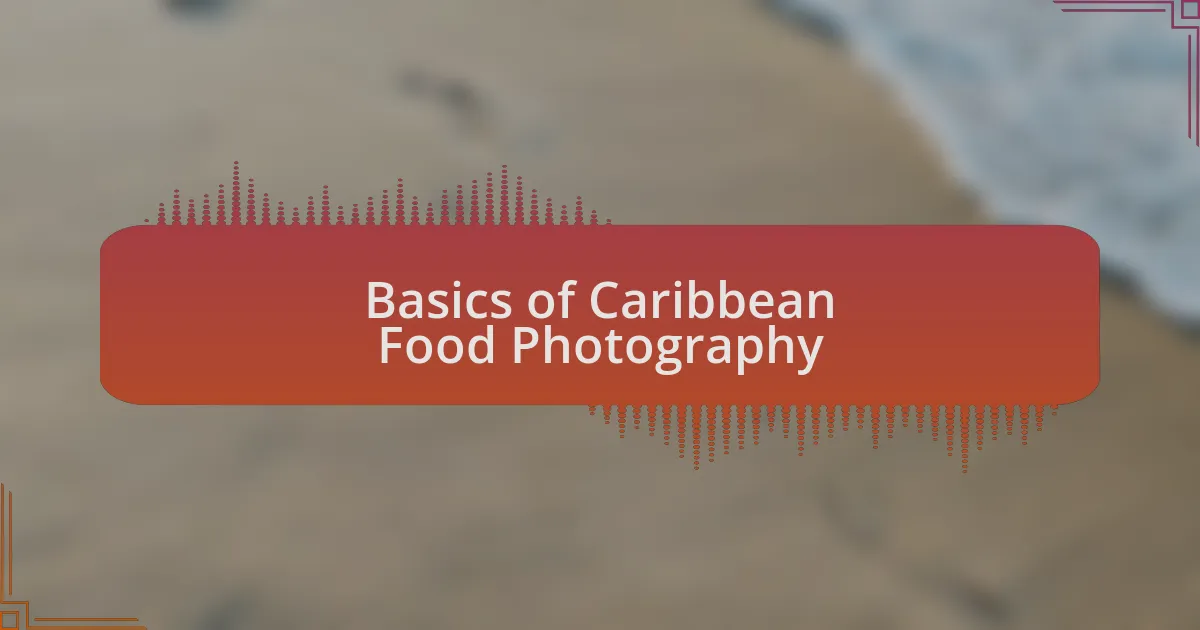
Basics of Caribbean Food Photography
Capturing the essence of Caribbean cuisine through photography involves a few essential techniques. I remember my first experience trying to shoot a vibrant plate of jerk chicken accompanied by colorful sides. Using natural light to accentuate the dish not only highlighted the spices infused within the chicken but also enhanced the lush greens and yellows of the sides, creating a mouthwatering scene. What’s fascinating is how different times of day can dramatically change the way colors pop.
One key aspect I’ve learned is the importance of composition. For instance, when I photographed a classic rice and peas dish, I arranged it on a rustic wooden table with tropical leaves framing the shot. This not only drew attention to the dish but also told a larger story about the Caribbean’s rich natural surroundings. Positioning elements in the frame can create an inviting scene. Have you ever considered how the placement of a single ingredient could shift the entire mood of the photograph?
Editing plays a crucial role in enhancing food photography, too. After capturing vibrant sunset-colored cocktails on a beach with golden sand beneath, I used subtle adjustments to deepen the hues and brighten the image, making it feel almost as refreshing as sipping the drink itself. The final result wasn’t just a photo; it became an invitation to experience the joy of the Caribbean lifestyle. Isn’t it incredible how a few edits can convert a simple capture into a vacation-ready postcard?
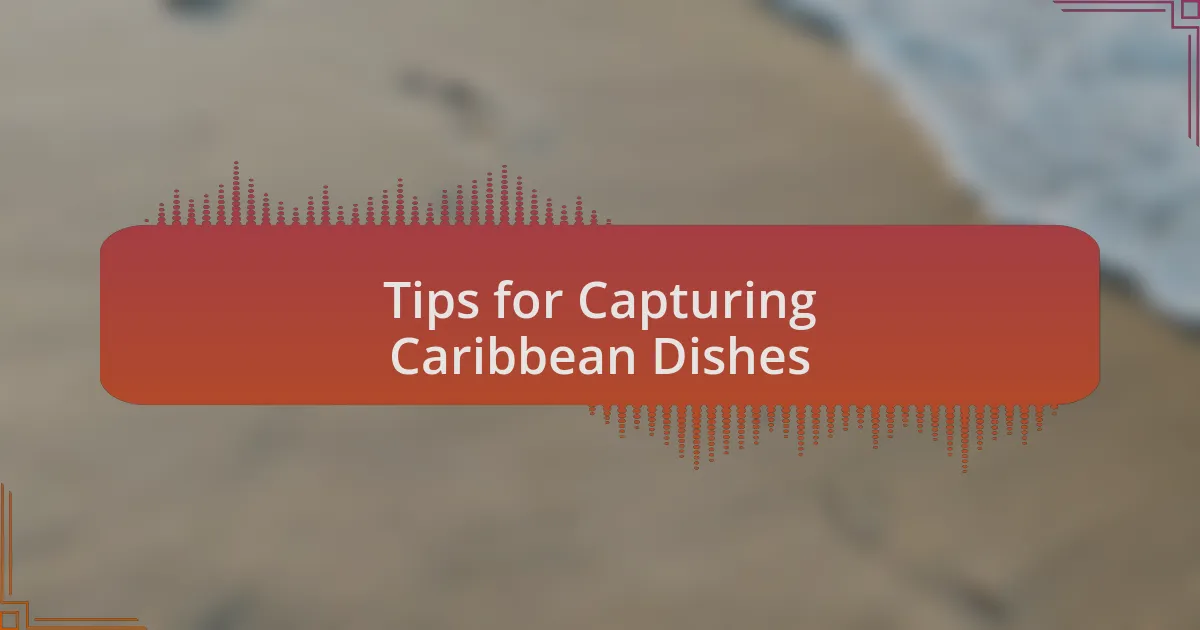
Tips for Capturing Caribbean Dishes
When it comes to capturing Caribbean dishes, I’ve learned that it’s all about the details. I vividly remember photographing a vibrant plate of conch fritters that were piled high and golden brown. I positioned the camera slightly above, allowing the texture of the fritters to shine through, and dotted the plate with a splash of bright sauce for that extra pop. Isn’t it amazing how a simple angle can expose the hidden beauty of a dish?
Don’t underestimate the power of props in food photography. One time, I experimented by including a colorful woven tablecloth from the islands underneath a luscious bowl of mango salsa. The rich patterns created a lively backdrop that mirrored the freshness of the ingredients. How do you think the textures in the surrounding scene impact the viewer’s appetite for the dish?
Finally, consider the story you want to tell through your images. During a sunset dinner shoot at an oceanfront restaurant, I captured a local seafood platter, enhanced by the breathtaking hues of the sky. The combination of the vibrant dish with the natural beauty of the sunset created a sense of place that was irresistible. Isn’t it worth pondering how food and environment can work harmoniously to evoke the true essence of the Caribbean?
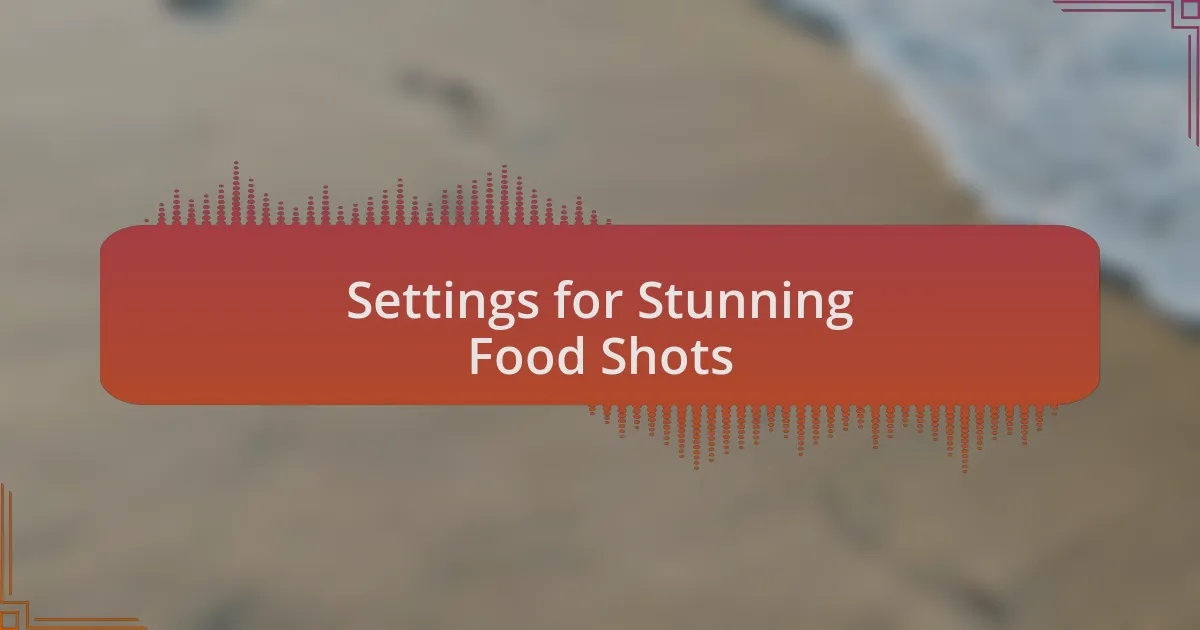
Settings for Stunning Food Shots
When shooting food, lighting is everything. I recall one afternoon at a quaint café in St. Lucia, sitting by a window that flooded the table with soft, natural light. It transformed an ordinary coconut curry into a radiant masterpiece, making the colors pop in a way that artificial lighting simply couldn’t replicate. Have you ever noticed how food seems to glow in the right light?
The setting you choose can elevate the mood of your food shots dramatically. On a recent trip, I found a rustic outdoor table surrounded by lush greenery and bright tropical flowers. I placed a bowl of fresh ceviche, adorned with sliced peppers and a lime wedge, right in the middle. The vibrant colors of the dish against the natural backdrop created a visual feast that drew the eye. What elements in a setting do you believe could enhance or distract from the food itself?
Lastly, experimenting with depth in your composition can result in stunning imagery that leaves a lasting impression. During a photoshoot of a classic Caribbean breakfast, I layered different heights by stacking slices of toast beside a beautifully arranged plate of ackee and saltfish. The varying levels offered a dynamic perspective that invited viewers into the scene as if they were sitting right there with me. Have you ever thought about how perspective can change the entire story of a meal?
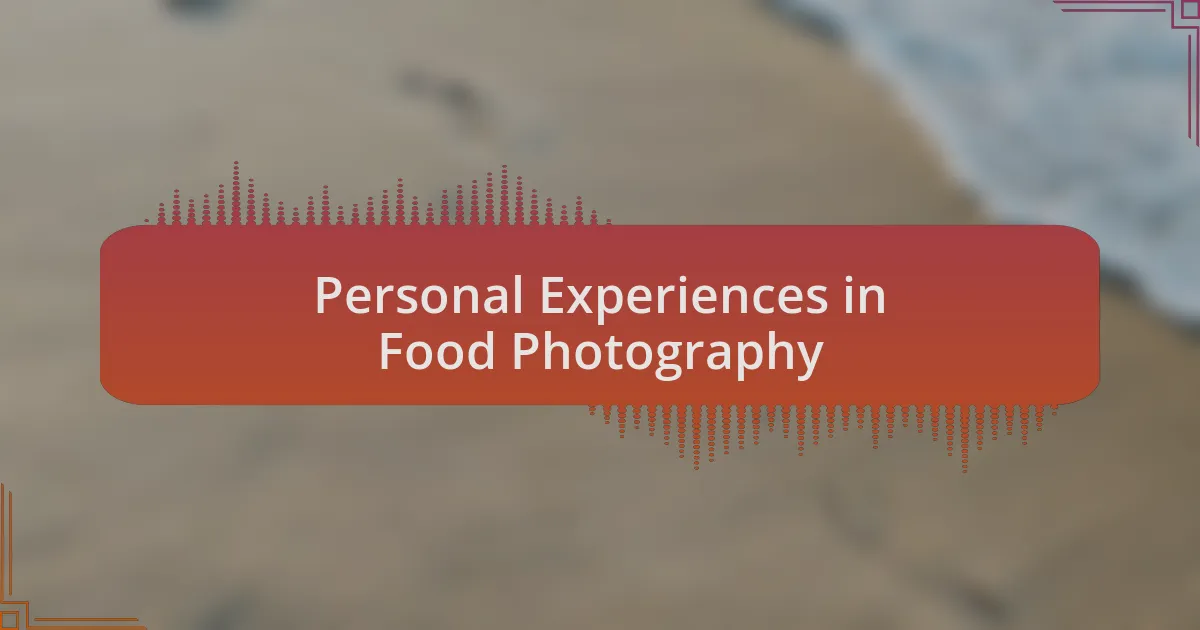
Personal Experiences in Food Photography
Capturing the essence of a dish often comes down to the little details. Once, while photographing a decadent chocolate cake at a beachside restaurant in Barbados, I noticed the glaze shimmering under the afternoon sun. I felt an instant rush of excitement as I realized that those small reflections added an extra layer of richness to the image. Have you ever considered how the tiniest details can transform a straightforward shot into something mesmerizing?
During one of my culinary adventures, I encountered a colorful array of street food in Jamaica. I made it my mission to photograph jerk chicken right off the grill, surrounded by vibrant vegetables. The scent wafted through the air, and I found myself nearly salivating as I clicked away. It was a perfect moment: the sizzling sound combined with the vivid colors and perfect lighting reminded me that food photography isn’t just about visuals; it’s about evoking taste and emotion. Have you felt that connection with food when you see it perfectly captured in a photograph?
One memorable experience involved a family gathering in Trinidad, where a cousin brought over homemade roti. I decided to capture not just the roti itself, but the joy it brought to everyone around the table. As I clicked away, I watched my family share stories and laughter, and it hit me that food photography is more than just aesthetics; it’s about storytelling. Do you think a photograph can capture the warmth of a shared meal and the bonds formed over it?

Lessons Learned from My Journey
There are times when I underestimated the power of natural light while photographing food. One evening, as I was photographing a plate of fish tacos at sunset in the Caribbean, I was struck by how the fading light transformed the colors in the dish. It made me realize that lighting can either enhance or detract from the image, reminding me to always be mindful of my surroundings. How often do you consider how light affects your photographs?
I remember setting up my camera to capture a vibrant fruit platter at a local resort. As I adjusted the angle to show the juicy slices of pineapple and mango, a curious child approached me and asked about my camera. In that moment, I learned that food photography can spark interest and curiosity, creating an opportunity for connection. Have you ever noticed how food has the power to bring people together, even through a simple photograph?
Reflecting on my journey, I found that patience is key. There were countless times when I had to wait for the right moment, like the time I was capturing a cocktail being poured at a poolside bar. The memory of that perfectly timed shot—the liquid cascading against the glass—is a reminder that great photos often require a little persistence and dedication. What have you learned about patience in your own creative adventures?